Teen reports 'gray spots' in left eye gradual vision loss in both eyes
Dilated fundus exam found multiple, circumscribed, deep, white subretinal lesions in the macula, more in the left eye than the right.

Thomas A. Albini

Vishak J. John
This case illustrates the key diagnostic findings in a rare retinal disease that has a long differential and may easily be confused with similar conditions. Recognizing these findings has important prognostic and therapeutic consequences.
A 13-year-old African-American boy was referred to our clinic for a second opinion on blurry vision and retinal lesions. He had presented to an outside retina specialist with a history of “gray spots” in his left eye for a week after being hit in the eye with a bean bag. Upon further questioning, the patient admitted that he had been experiencing gradual vision loss in both eyes for several months, with acute worsening in the last week. The patient was otherwise healthy and denied any recent illness, fever or headache. His medical history was unremarkable, and a complete review of systems and family history was negative.
On exam, the patient’s visual acuity was 20/100-1 in the right eye and 20/50-1 in the left eye. IOP was normal at 18 mm Hg in the right eye and 17 mm Hg in the left eye, with normal pupillary response and no relative afferent pupillary defect. Anterior segment exam was within normal limits with no cells in the anterior chamber or anterior vitreous cavity. Dilated fundus exam revealed a clear view with normal, sharp, pink optic nerves in both eyes. There were multiple, circumscribed, deep, white subretinal lesions in the macula, seen in the left eye greater than the right eye, without any evidence of vitritis or vasculitis (Figure 1).
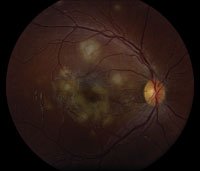
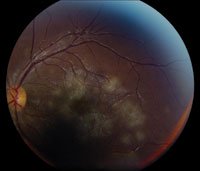
Figure 1. Multiple circumscribed, deep, white subretinal lesions in the macula, seen in the left eye greater than the right eye, without any evidence of vitritis or vasculitis.
Images: Albini TA, John VJ


Figure 2. OCT shows intact external limiting membrane and inner/outer segment junction at the fovea.
Optical coherence tomography of both eyes demonstrated overall integrity of the retinal layers, especially an intact external limiting membrane and inner segment/outer segment junction at the fovea (Figure 2). Fluorescein angiogram of both eyes revealed early hypofluorescence consistent with non-perfusion and late hyperfluorescence consistent with leakage and staining (Figure 3). Indocyanine green (ICG) angiography showed significant foci of hypofluorescence throughout (Figure 4).
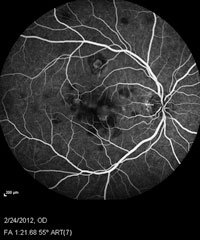
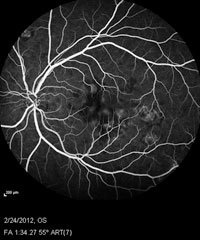
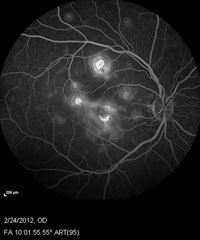
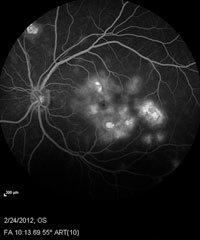
Figure 3. Fluorescein angiogram of both eyes shows early hypofluorescence consistent with nonperfusion and late hyperfluorescence consistent with leakage and staining.
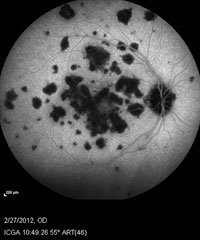
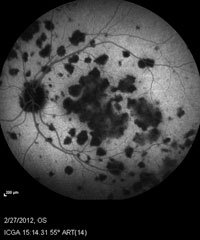
Figure 4. Indocyanine green angiography shows significant foci of hypofluorescence throughout.
At the initial visit, a uveitis workup was initiated, including placement of a purified protein derivative, angiotensin converting enzyme, Bartonella titers and chest radiograph, and the patient was asked to follow up in a few days. Three days after the initial presentation, the patient returned with decreasing vision of 20/200 in the right eye and 20/70 in the left eye. Posterior segment examination revealed an increasing number of lesions and extensive peripheral spread.
After excluding infectious etiologies, the patient was started on oral prednisone, dosed appropriately for his weight. One month after initiating systemic steroid therapy, vision returned to 20/30 in both eyes, with scar-like changes to the white subretinal lesions. Despite this substantial improvement in vision, the patient and his family are considering long-term immunosuppression with oral methotrexate.
The diagnosis
Relentless placoid chorioretinitis (RPC) is a white dot syndrome characterized by bilateral creamy white lesions at the level of the retinal pigment epithelium, extending beyond the posterior pole into the retinal periphery. It is an entity that has similar clinical features to both acute posterior multifocal placoid pigment epitheliopathy (APMPPE) and serpiginous chorioretinitis, yet with a different clinical course and prognosis compared with those two white dot syndromes. Described only in 2000 as a distinct entity, the condition may have been referred to historically as ampiginous chorioretinitis or multifocal serpiginous choroiditis. According to available literature, RPC affects a young population (second and third decades of life) without any gender predominance or any systemic associations.
While APMPPE is characterized by a monophasic disease that affects mainly the posterior pole, RPC has retinal lesions in the mid and far periphery, with a much longer clinical course marked by multiple recurrences. The number of lesions in RPC is also greater than in APMPPE, with typical patients presenting with more than 50 creamy white lesions. Serpiginous chorioretinitis, on the other hand, is characterized by prolonged, recurrent clinical course and a poor visual prognosis. RPC is similar to serpiginous chorioretinitis in its clinical course and recurrences but differs in its more anterior location and much better visual prognosis.
The diagnosis of RPC is clinical, based on fundus examination, and can be aided by additional imaging modalities. Vitritis is typically moderate, although this was not the case in our patient. On dilated exam, more than 50 deep white lesions in the posterior pole with extension anterior to the equator is characteristic. Fluorescein angiography demonstrates early hypofluorescence due to nonperfusion of the choriocapillaris, late hyperfluorescence consistent with staining of healed lesions, and leakage in active lesions. Additionally, ICG angiography shows prominent hypofluorescent lesions throughout the time course of the study. Most importantly, the course of the disease, ie, long clinical progression and multiple recurrences, helps distinguish RPC from typical APMPPE.
The ideal treatment for this condition is still unknown. While APMPPE is traditionally thought to be self-limited without treatment, patients with serpiginous chorioretinitis always require long-term immunosuppressive therapy. Studies seem to indicate that systemic corticosteroids can improve visual acuity. In a paper by Jones and colleagues, five out of six patients regained useful vision with systemic steroid treatment. However, the disease can progress and recur while on steroid therapy. In some cases, additional immune modulation is necessary with agents such as azathioprine, mycophenolate mofetil and cyclosporine. The long-term need for chronic steroid-sparing immunosuppression in RPC is still unclear; however, the observation of frequent recurrences suggests benefit from long-term treatment. Fortunately, with early treatment, most patients with RPC regain a substantial amount of vision.
Overall, RPC likely represents a disease that falls into a spectrum of conditions including APMPPE and serpiginous chorioretinitis. In this case report, we highlight the salient clinical and diagnostic features of this lesser known white dot syndrome.
References:
- Jones BE, Jampol LM, Yannuzzi LA, et al. Relentless placoid chorioretinitis: A new entity or an unusual variant of serpiginous chorioretinitis? Arch Ophthalmol. 2000;118(7):931-938.
- Jyotirmay B, Jafferji SS, Sudharshan S, Kalpana B. Clinical profile, treatment, and visual outcome of ampiginous choroiditis. Ocul Immunol Inflamm. 2010;18(1)46-51.
- Lim WK, Buggage RR, Nussenblatt RB. Serpiginous choroiditis. Surv Ophthalmol. 2005:50(3);231-244.
- Yeh S, Lew JC, Wong WT, Nussenblatt RB. Relentless placoid chorioretinitis associated with central nervous system lesions treated with mycophenolate mofetil. Arch Ophthalmol. 2009;127(3):341-343.
For more information:
- Thomas A. Albini, MD, can be reached at Bascom Palmer Eye Institute, 900 NW 17th St., Suite 245, Miami, FL 33136; 305-482-5006; fax: 305-326-6417; email: talbini@med.miami.edu.
- Disclosure: No products or companies are mentioned that would require financial disclosure.
